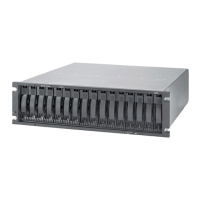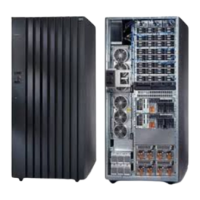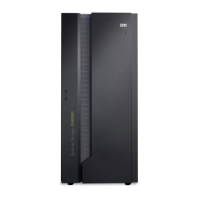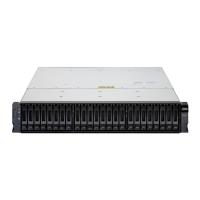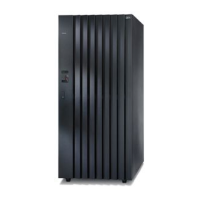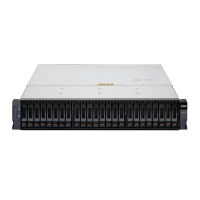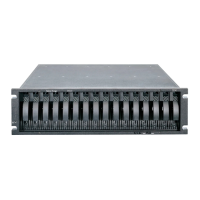Connecting storage expansion enclosures to the DS4800
Attention
Before you power on the DS4800 Storage Subsystem, the DS4800 must be
cabled to at least one storage expansion enclosure populated with at least two
drives. If at least two drives are not installed in each attached storage
expansion enclosure when you power on the DS4800, your standard storage
partition key will be lost and will need to be regenerated using instructions on
the IBM DS4000 Solutions and Premium Features Web site:
https://www-912.ibm.com/PremiumFeatures/
Additionally, if at least two drives are not installed in each attached storage
expansion enclosure, the resulting insufficient load to the storage expansion
enclosure power supply CRUs might cause the drive expansion enclosure
power supply CRUs to intermittently appear as failed and then reappear in an
optimal state, falsely indicating that the power supply CRUs are bad.
In the initial installation of the DS4800, you can add only new storage expansion
enclosures to the DS4800 Storage Subsystem. This means that there must be no
existing configuration information on the storage expansion enclosures that you
want to install.
If the storage expansion enclosures that you want to install currently contain logical
drives or configured hot spares, and you want them to be part of the DS4800
Storage Subsystem configuration, refer to the IBM System Storage DS4000 Hard
Drive and Storage Expansion Enclosure Installation and Migration Guide. Improper
drive migration might cause loss of configuration and other storage subsystem
problems. Contact your IBM support representative for additional information.
Redundant drive channel pair
For the DS4800, each drive channel (see the Glossary definitions for ″drive
channels″ and ″drive loops″) is associated with two ports, and there are two drive
channels and four associated ports per controller. The total number of drives per
drive channel is 112. One channel from each controller combines to form a pair of
redundant drive channels. See Table 16 on page 68 for channel and port labeling
conventions.
In Figure 41 on page 61 and Figure 42 on page 62, drive channel 1 of controller A
and drive channel 3 of controller B combine to form a DS4800 Storage Subsystem
drive channel pair. If any component of drive channel 1 fails, the RAID controllers
can still access the storage expansion enclosures in drive channel 1 through drive
channel 3. Similarly, drive channel 2 of controller A and drive channel 4 of controller
B combine to form the second of the two DS4800 Storage Subsystem drive channel
pairs. If any component of drive channel 2 fails, the RAID controllers can still
access the storage expansion enclosures in drive channel 2 through drive channel
4.
Figure 41 on page 61 shows the storage expansion enclosures in each drive
channel pairs connected to only one drive port in the two-ported drive channel. For
example, in drive channel pair 1, only port 4 of channel 1 and port 1 of channel 3
are used. Figure 42 on page 62 shows that half of the storage expansion
enclosures in each drive channel pair are connected to the first port of the
Chapter 3. Cabling the storage subsystem 59
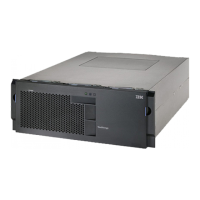
